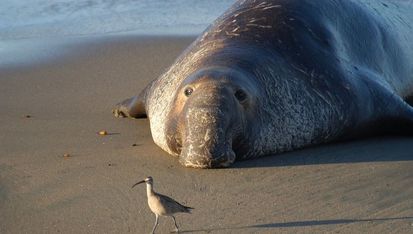|
Northern elephant seals spend a lot of their time in the sea, but during breeding season, females must come to shore to raise their young pups. During the first month of life, elephant seal pups cannot swim, so mothers must stay on the shore to protect their pups. Like most animals that generate their own heat (i.e., endothermic animals), elephant seals have to keep their body temperature within a narrow range. Overheating leads to heat stress (i.e., hyperthermia), which can harm future reproduction and long-term survival, and can even cause death. Elephant seals usually stay within the appropriate temperature range by going into the water to cool down. However, during breeding season, male elephant seals may attempt to mate with unreceptive adult females that approach the water’s edge. These unwanted mating attempts can harm the females, so cooling off in the water may not be the best strategy for adult females with pups during the breeding season.
Researchers wondered how the current weather and environment affected elephant seal mothers and their pups, especially if mothers and pups were to avoid those undesired male interactions. They measured the surface temperature of adult female elephant seals and pups during the breeding season at Point Reyes National Seashore, and they looked at ambient temperature, relative humidity, solar radiation, and wind speed, while observing the behavior of mothers and pups. Elephant seal pups were generally warmer than their mothers, and both were warmer than the ambient temperature. Both mothers and pups were warmer during periods of higher solar radiation (vs. periods of lower solar radiation). Despite the potential risk of unwanted male elephant seals and the fact that pups are unable to swim in their first month of life, mothers and pups still went to the water to cool down, particularly during times of high solar radiation! Climate change could lead to significant changes in solar radiation and ambient temperatures. These changes will shape elephant seal breeding behavior. The need to release excess heat could be a driving factor that shapes elephant seal social behavior during breeding seasons and could be used to predict where elephant seals will breed in the future. Original research paper can be found here: https://www.ncbi.nlm.nih.gov/pubmed/27712667 Can't access the original article? Find out more details about this article on our database: http://www.opensciencedb.com/federal-agency-research-db.html#federal-research-db/medical-research-db-detail/58c85b05d434b42ac08e1233/ |
AuthorsWe are grad students and scientists dedicated to disseminating Are you a student or postdoc? We need your help to deliver scientific facts to the public!CategoriesArchives |
|
|



